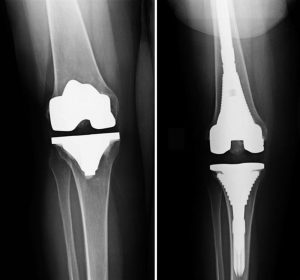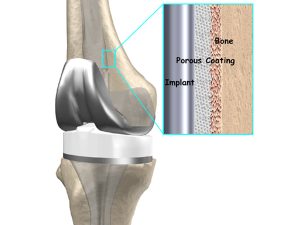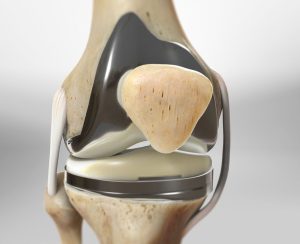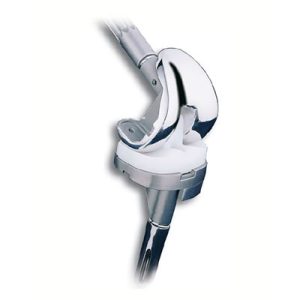Revision Total Knee Replacement
What is Revision Total Knee Replacement?
Total knee replacement is one of medicine’s most effective treatments. It allows patients to live fuller, more active lives free of persistent knee pain in the great majority of situations. A knee replacement , on the other hand, may fail over time for a variety of reasons. Your knee may become painful and swollen as a result of this. It might also feel stiff or unsteady, making it difficult to go about your daily routine.

When is a Revision Total Knee Replacement Required?
Loosening and Wear of Implants:
An implant must remain securely linked to the bone in order for a complete knee replacement to operate effectively. The implant was either cemented into the bone or press-fit to allow the bone to grow onto the surface of the implant during the initial operation. The implant was firmly secured in both cases. However, an implant may loosen from the underlying bone over time, producing discomfort in the knee. High-impact activities, extra body weight, and deterioration of the plastic spacer between the two metal components of the implant are all variables that may lead to loosening. Patients who have their first knee replacement while they are younger may also “outlive” the life expectancy of their prosthetic knee. These individuals have a higher long-term risk of requiring revision surgery owing to loosening or wear.
Instability:
Your knee may become unstable if the ligaments that surround it become injured or unbalanced. Because most implants are intended to operate with the patient’s existing ligaments, any alterations to those ligaments may cause the implant to fail. Recurrent swelling and the sensation that your knee is “giving way” are possible symptoms. If nonsurgical treatment options such as bracing and physical therapy are ineffective, revision surgery may be required.
Stiffness:
A complete knee replacement may not always provide you with the range of motion you require to accomplish daily tasks. This might develop if there is too much scar tissue around the knee joint. If this happens, your doctor may try “manipulation under anaesthesia.” You will be given an anesthetic for this treatment so that you will not feel any discomfort. The doctor then tries to break up the scar tissue by bending your knee. In the vast majority of instances, this surgery improves the range of motion. The knee, on the other hand, might sometimes stay stiff. If your range of motion is limited by scar tissue or the position of the components in your knee, revision surgery may be required.
Infection:
Any surgical surgery, including total knee replacement, has the risk of infection. Infection might strike while you’re still in the hospital or after you’ve returned home. It might even happen years later.
It’s possible that an infected artificial joint will become stiff and uncomfortable. The implant’s connection to the bone may begin to deteriorate. Even though the implant is securely attached to the bone, discomfort, swelling, and infection drainage frequently necessitate revision surgery.
Fractures:
A periprosthetic fracture is a damaged bone that develops surrounding the total knee replacement components. The most common cause of these fractures is a fall, and they almost always need revision surgery. Your doctor will examine many aspects when deciding the amount of revision required, including the quality of the remaining bone, the kind and location of the fracture, and if the implant is loose. When a portion of bone is broken or weakened due to osteoporosis, it may be necessary to entirely replace the damaged section with a bigger revision component.
When do you need Knee Revision Surgery? What are the Signs?

ome patients may wonder when they should really proceed with the revision knee replacement surgery. If your discomfort is caused only by weakness, as we described, physical therapy and strengthening exercises will typically suffice. Multiple years after a complete knee replacement, your ligaments may stretch out and the knee may no longer be as stable as it once was, meaning that when a surgeon touches your knee, it may seem a little looser to them. Some patients are able to tolerate it, while others are unable to. If you’ve tried physical therapy and your knee still doesn’t seem to be getting better, you may require knee revision surgery.
Medical Evaluation:
A full physical examination with your primary care physician will be required several weeks prior to revision surgery. This is required to ensure that you are in good enough health to have surgery and recover fully. Before surgery, patients with chronic medical issues, such as heart disease, maybe assessed by a specialist, such as a cardiologist.
Tests
Imaging tests are performed. To understand more about the state of your knee, your doctor will generally request imaging studies.
- X-rays. Images of dense structures, such as bone, can be obtained using this method. To check for loosening or a change in the location of the components, your doctor may request x-rays around the joint replacement region.

- Other types of imaging examinations. If the prosthesis has loosened from the bone, a nuclear medicine bone scan may be used to identify this. A magnetic resonance imaging (MRI) or computed tomography (CT) scan may be done in some circumstances to assist discover why your knee has failed and offer more information about the bone’s state.
- Tests in the lab. Your doctor may prescribe blood tests to check whether you have an infection. He or she could aspirate your knee as well. A needle and syringe are used to extract joint fluid, which is subsequently examined in a laboratory to see if the infection is present.
Home Planning

If you live alone, you may need assistance with duties such as cooking, shopping, bathing, and doing laundry for many weeks because your movement will be limited following surgery. Your doctor’s office, a social worker, or a hospital discharge planner can aid you in making plans for someone to support you at home.
You may need to stay in a nursing facility or rehabilitation center after you leave the hospital, depending on your condition. If necessary, your healthcare team can assist you in arranging a short stay in an extended care facility throughout your recuperation.
Risks and Complications
The following are some of the potential risks and problems of revision surgery:
- Wound healing is poor
- Knee stiffness or reduced range of motion
- Infection in the wound or infection in the prosthetic
- Blood clots in the legs that might go to the lungs (pulmonary embolism)g
- During surgery, a bone fracture occurs
- Nerve and blood vessel damage
Heart attack, lung troubles, or stroke are examples of medical issues
What is the Procedure?
The procedure for revision total knee replacement is more complicated and time-consuming than the procedure for first total knee replacement. The procedure may take several hours in more complicated circumstances. To begin, your doctor will trace the incision line from your original total knee replacement surgery. However, the incision may be longer than the original to allow for the removal of the old components. The doctor will next shift the kneecap and tendons to the side to display your knee joint once the incision is done. The soft tissues of your knee will be examined by your doctor to ensure that they are clear of infection.

He or she will examine all of the prosthesis’ metal and/or plastic components to see which ones have gotten worn, loose, or moved out of place. If required, your doctor will gently remove the original implant so that as much bone as possible is preserved. This is also removed if cement was utilized in the original total knee replacement. Removing the cement from the bone is a time-consuming operation that adds to the revision surgery’s complexity and duration. Your doctor will prepare the bone surfaces for the revision implant after removing the initial implant. There may be substantial bone loss around the knee in rare situations. To compensate for the bone inadequacies, metal augments and platform blocks can be added to the primary components. The bone graft material may be utilized to help repair the knee in rare cases. The transplant might be from your own bone (autograft) or another person’s bone (donor graft) (allograft). Finally, your doctor will place the specific revision implant, heal any damaged surrounding soft tissues, and thoroughly evaluate the joint’s mobility. A drain may be inserted into your knee to collect any remaining fluid or blood following surgery. After surgery, you’ll be taken to the recovery room, where you’ll be observed for many hours while your anesthetic recovery progresses. You will be transferred to your hospital room after you have awoken.
Why Choose Dr. Abhijit S. Agashe ?
Dr Abhijit S. Agashe is the Best Knee Replacement Surgeon in Pune who performs the surgery using all the advanced technology which gives the best result. He is the most experienced orthopedic surgeon in Pune
Agashe Clinic
- Research Award by Bone and Joint Decade – 2004
- Esteemed Fellowship Offered By The AO Group From Switzerland – 2008
- Fellowship With Prof. Willium Peterson From Germany In Sports Medicine – 2007
Address
- Office no 206, Siddharth Towers Building no 1 Near Karishma society, Kothrud, Pune, Maharashtra 411029
- 086006 53737
- [email protected]



